


Refer to the exhibit. A developer wants to automatically deploy infrastructure for a containerized application. A .gitlab-ci.yml file must describe a pipeline that builds a container based on a supplied Dockerfile and executes an Ansible playbook on the configured container. What must be added where the code is missing to complete the script?
A.
B.
C.
D.
doble_h
1 year, 1 month agoThePokemonNuzlockingMaster
1 year, 6 months agoAZRA06887
1 year, 6 months agocj_kuo
1 year, 9 months agoTeringzooi
2 years, 3 months agoQuiShong
2 years, 6 months agoTeringzooi
2 years, 3 months agobboycoi
2 years, 7 months ago